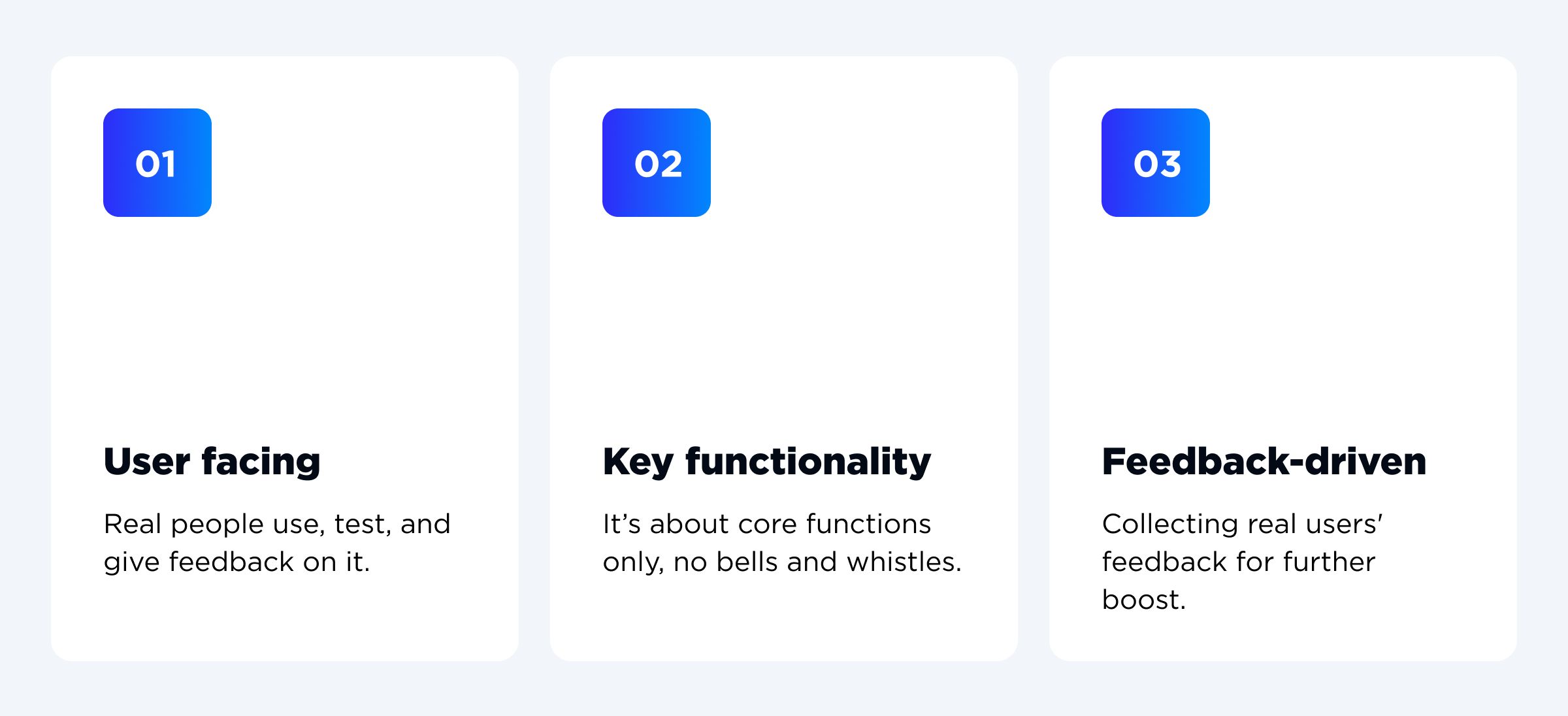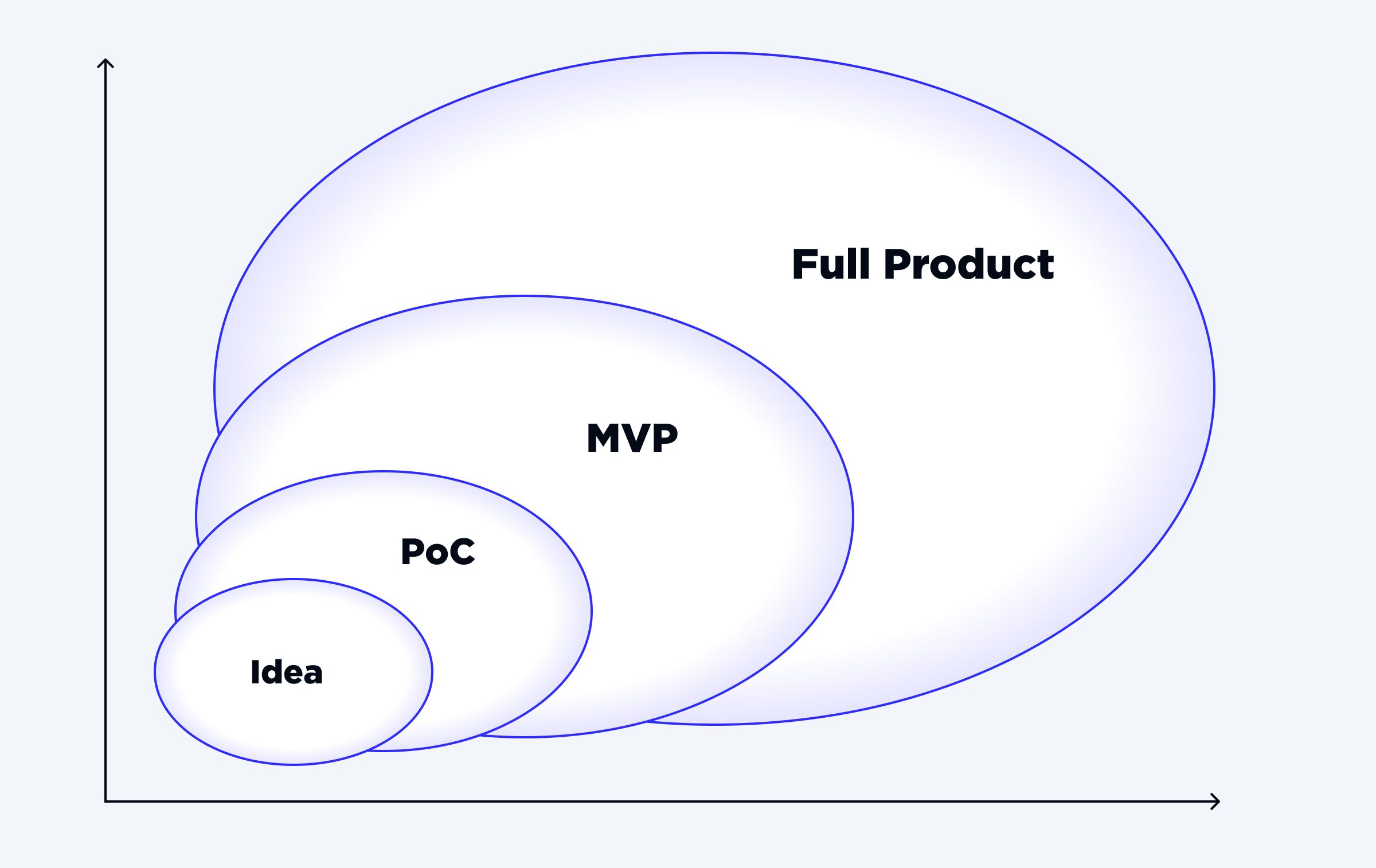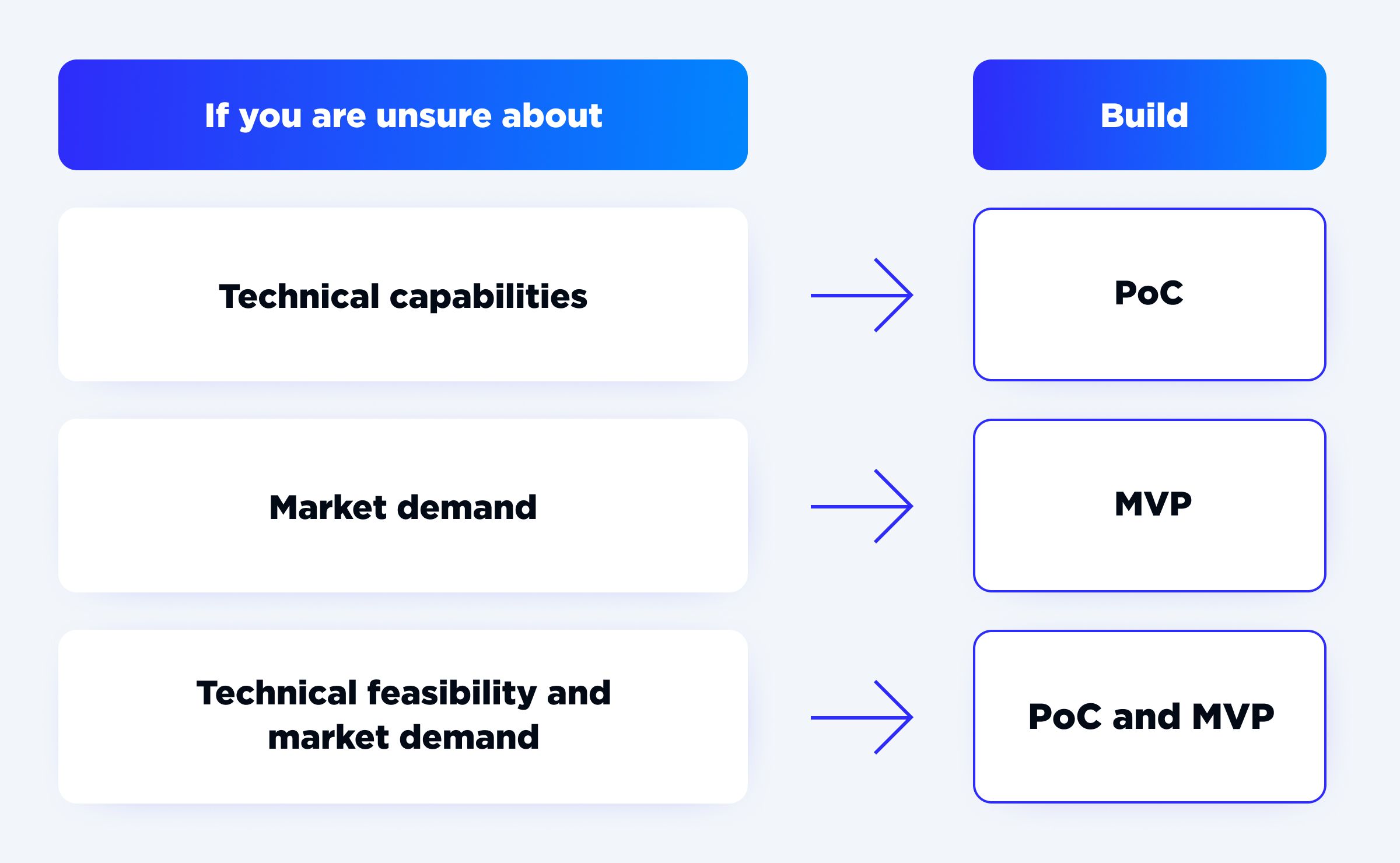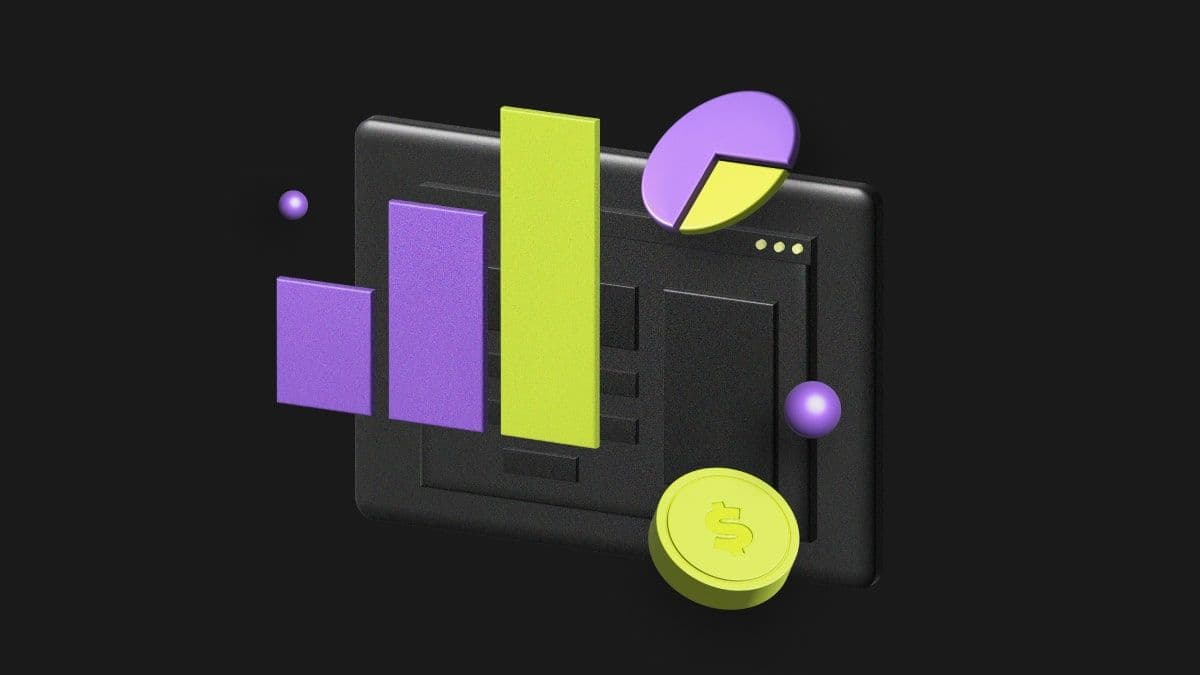How many of you have ever come up with a brilliant idea and wanted to make a difference in the world? However, I’m sure you faced the key challenge, “How do I know if it actually works?” or “Does anyone even need it?”
These are reasonable questions to ask. And, obviously, you need validation. I should warn you that before you jump into full-cycle development, make sure you validate and test two major things:
- Is it possible to build this product?
- Will people need and use it?
As soon as you have answers to these questions, you will have peace of mind that your efforts will serve you well. You might be wondering how to make it happen. Well, that’s where PoC (Proof of Concept) and MVP (Minimum Viable Product) step in. Many people tend to confuse or compare PoC vs MVP. However, I must mention that they are worlds apart in purpose. Going back to the abovementioned questions, a PoC answers the first one while an MVP brings clarity with the second one.
Startups should be especially aware of opting for a PoC at first. Luckily, about 80% of concepts are validated. However, only 10-25% of them progress to the full-scale development. There’s a positive side, though. 82% of startups that succeeded began with a simple version of their product, MVP.
As you can see, it’s not about choosing proof of concept vs MVP but rather using them together. Where should you start? I will cover the main definitions of both, their differences, when to use them, and what to avoid in this article. Stay with me and make more informed decisions!
What Is a PoC (Proof of Concept)?
Starting off, what is PoC? It’s not a rhetorical question. I'm going to answer this one. The answer lies in its name. It is about the proof that your idea can actually work out with the chosen tech stack.
A Proof of Concept is a small test to explore technical feasibility before launching a final product.This is not about impressing your users. It is rather about “impressing yourself” (or investors and stakeholders) and confirming that your idea is not just a dream. If you remember a research paper from uni, it is similar to creating a hypothesis and testing if it works in real-world conditions.
In my humble opinion, you should also know what the main goal is and what PoC stands for in business. You find out if it is possible to turn your idea into a product.
What are the most common characteristics of a PoC for you to remember?

Understanding what it is, I’d like to provide you with examples of when companies build PoCs.
- Trying out a VR or AR training program and testing whether it improves learning results.
- Checking an AI assistant in a logistics system and determining whether it helps reduce delivery times and costs.
- Testing a smart home system and ensuring all IoT devices interact without delays or errors.
If you’d like me to give you another simplified explanation of a PoC, I’d call it a green light for further development of the product. It gives you the confidence you need to proceed with the solution.
What Is an MVP (Minimum Viable Product)?
Now, I’ll be switching gears. So, what is MVP? As you already know, whether your idea is technically possible thanks to PoC, now you should figure out if anyone is even interested in your product.
An MVP is a simplified version of your product that has all the essential features to collect feedback from real users.It is crucial for startups and companies to be aware of what MVP stands for in business. A Minimum Viable Product is like the next stage of the proof of concept. It is rather risky to build a full-scale product until you know the actual market demand and what users think about it.
Defining the main goal of an MVP, I’d say that it’s about validating whether your product fits the market, allocating minimal resources.
Similar to a PoC, an MVP has its own characteristics. Let’s explore!

Since you already know and understand what an MVP is, let me provide you with some common examples of its usage in real life.
- Building a small marketplace for handmade stuff and measuring buyers' and vendors’ activity.
- Launching an AI writing assistant and checking out whether people find it useful.
- Releasing an early version of a budgeting app and collecting insights from users on what financial tools they find helpful.
Altogether, an MVP is a great way for businesses to test the waters before diving in.
Discovering Key Differences Between PoC and MVP
As you’re familiar with both, let’s move on to the difference between PoC and MVP. To make it crystal clear, I’ve broken it down in the table below.
| Aspect | PoC | MVP |
| Purpose | Checks if an idea is technically possible | Tests the potential of a product on the market |
| Audience | Built for internal team (investors, stakeholders, founders, etc.) | Targets users and early adopters for real-time interactions and feedback |
| Focus | Proves one or a few technical or functional hypotheses | Delivers a basic product to check usability and get feedback |
| Scope | Narrow and specific, usually covers 1-2 key features | Broad scope, has essential functions to perform tasks |
| Output | A technical validation that stays behind the scenes, demo, or prototype | A working version of the product that is for real use, feedback, and final design |
| Duration | Short-term efforts, from a few days to several weeks | Longer to build, from a few weeks to several months |
| Success | The product can work technically | Users actually want and use the product |
I do hope you find this information enough for you to see the major distinctions between PoC and MVP for your further consideration.
When to Use PoC?
Now that you are introduced to the definitions and key differences, I’d like to make it clearer when to use both. Knowing what PoC stands for in business, you might have already understood that it is your go-to choice when you’re struggling with uncertainty in technology, and whether it’s possible to build it.
What is more, I’m happy to share some cases when PoC makes perfect sense. Let’s go!
- When you are exploring new, untested, or innovative technologies. It is related to AI models, blockchain, AR and VR, IoT, etc.
- This one is specifically topical for startups, as PoC is recommended when prepping for a pitch to investors or stakeholders. It helps you prove that your idea is realistic.
- Some projects are complex and require advanced integrations. So, it’s better to validate those integrations and technical dependencies to know if you can build full-scale systems.
- Every fresh idea is about investment. So, you’d better assess all possible technical risks before you spend significant development budgets.
Considering these cases, let’s explore some real-world examples that reveal my point.
- You run a financial institution and need to test an AI-driven fraud detection model. It is sensitive data and requires a rigorous approach.
- You want to create a small blockchain ledger to verify transaction speed. Again, it’s complex and involves sensitive information and big budgets.
- You have a traffic overload and need to try a new API. As it is a new tech, you should check whether it handles those traffic loads before implementing.
As you can see, a PoC moment comes the second you question whether something will even work.
When to Use MVP?
Moving on to the next point, let me remind you what MVP stands for in business. When you have an idea and are confident in technologies, but are still not sure whether people will find it useful.
This is a rather general explanation of when to opt for it. Such a validation through experience is great and discloses whether your product will solve the problem. So, what are the cases?
- When you are about to market the product and need to test how it fits the market before making a large investment.
- You can’t go further with development without users' reviews. So, you launch a simplified version and collect their feedback.
- There are some business hypotheses, e.g., usability, features, and pricing, that need validation. The best way to do so is to “ask” end users.
- For a better launch of the final product, you need to attract early customers. An MVP is the solution you and your users need.
Need some examples? Of course, you do! And I’ve prepared for that with a few examples when MVP hits it off.
- There’s a startup that needs to test people’s interest in their product. So, they release a simplified app and check out sign-ups and engagement.
- The company is working on a new SaaS platform. To figure out all the needed features and functionality, they may offer a limited MVP to early testers.
- There is a fintech business struggling to understand whether clients are going to trust a new product. They launch an MVP to gauge customers' trust and usability.
Going back to the beginning of the article, an MVP gives an answer to the question whether people will need and use your product.

Let OTAKOYI validate your ideas and take you to the market!
CONTACT USCan You Build Both?
Having reached this far, you might be curious whether you can build both and not choose between proof of concept vs MVP. Good news! You absolutely can! I can even say that is how successful products do.
So, how does the best development roadmap look?

We’ve partially covered this, but let’s briefly discuss how it works.
- You get an idea and need to find out whether it’s not just some fantasy.
- You design a PoC and ensure your idea can be implemented technically.
- As soon as your concept is proven, you move on to developing an MVP and check out whether the market demands it and how it fits.
- Now that you’ve gathered enough validation and insights, you can proceed with developing a full-scale product with all the features.
Moving on, I’d like to say that there are multiple benefits your startup or company can get when combining PoC and MVP. Let’s have a quick view of what you can get.
- Reduced risk
- Smarter budgeting
- Faster validation
- Stronger investor confidence
- Better product quality
- Shorter time to market
Summing up, I can’t help mentioning that at first you test if it works and then test if it’s wanted. Sounds like a perfect way to make great products!
Common Mistakes to Avoid
This endless comparison of PoC vs MVP, choosing both or between them, and juggling the difference between PoC and MVP leads us to, in my opinion, a critical point. This is about doing everything right and avoiding some common mistakes people make.
- Mixing up PoC and MVP purposes
You should remember that PoC can’t tell you anything about user engagement. It’s the MVP’s goal. - Overengineering the PoC
You should remember that PoC is like a feasibility test, not a product. You can keep it simple. - Ignoring feedback during the MVP testing
The main purpose of an MVP is to collect feedback and learn from it. If you ignore that, you lose the point. - Skipping validation altogether
Going all in with a new product without PoC or MVP is like jumping off the plane without a parachute and hoping to find one on the way down.
If you do your best to avoid any of the mistakes mentioned above, you can sleep well knowing your product will be successful.
How Do You Choose the Right Approach?
So, you know the definitions, differences of proof of concept vs MVP, when to opt for them, and what mistakes to avoid. But the main question is, “What is the right way?” I’ll keep it brief when helping you figure out the answer and not get baffled.

This is as simple as that. Of course, I’d recommend consulting with a software partner for a better picture, because there are some underwater stones you might miss. If you ask me to wrap things up, I’m ready to provide you with checklists for both. Stay with me!
PoC is the right approach if:
- You are planning to involve a brand-new or complex technology in your product.
- You need to test performance limits or advanced integrations.
- You want to perfectly pitch your idea to investors or the internal team.
MVP is the right approach if:
- You want to know how your users might react to a new idea.
- Your team should find out whether the product fits the market.
- You want to scale and need to collect essential insights.
Have you already made up your mind what your company or startup needs between PoC vs MVP? If the fact that PoC is about “Can we build it?”, and MVP is about “Should we build it?” is not enough, I welcome you to contact our team. We are more than happy to help you on the way!
Final Words
Let’s put it all into perspective. Before building a final product, remember to validate it twice. Why? Because:
A PoC gives you technical confidence.
An MVP gives you market confidence.What is PoC? What is MVP? What is the difference between PoC and MVP? What to choose? Now you have all the answers and can easily make detailed decisions. I’m confident that you are informed about the consequences of skipping this validation stage.
However, the best advice I can share with you is telling you to find a dedicated partner to help you from day one. This is what we do at OTAKOYI. Our goal is to help startups and enterprises navigate through these stages smoothly and efficiently.
So, which stage are you in right now? No matter the stage, make sure you’re building smart, not “blind”.







